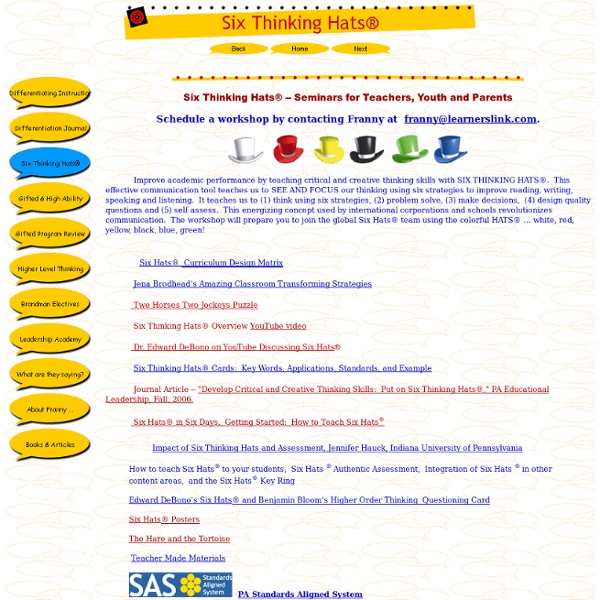Teaching the Gifted and Talented: 33 Websites Where You Can Find Good Resources
I wish the Internet was available to me as a kid in elementary school. In New York City, where I attended kindergarten through sixth grade, they called the gifted and talented class "SP". I remember being put into a class to learn French, but very little else.
Ten Takeaway Tips for Teaching Critical Thinking
Suggestions from educators at KIPP King Collegiate High School on how to help develop and assess critical-thinking skills in your students. Ideally, teaching kids how to think critically becomes an integral part of your approach, no matter what subject you teach. But if you're just getting started, here are some concrete ways you can begin leveraging your students' critical-thinking skills in the classroom and beyond. 1.
Ways To Differentiate Instruction - Classroom Q&A With Larry Ferlazzo
(This is the first post in a two-part series on differentiation) I posed this question last week: "What is the best advice you can give to a teacher about differentiating instruction?" I've shared my response in an Ed Week Teacher article that I've co-authored with my colleague, Katie Hull Sypnieski. It's titled "The Five By Five Approach To Differentiation Success." I'll limit my contribution here to sharing a useful link to The Best Resources On Differentiating Instruction.
Gifted Students - How To Information
Lessons Using Socratic Questioning for Gifted Students Socratic questioning is crucial to developing strong critical thinking skills, according to non-profit organization The Critical Thinking Society. The method is defined by a facilitator guiding students to evaluate their biases and reaching conclusions through a series of open-ended questions. Establishing a fair classroom environment in which all gifted students are able to speak and be heard is critical to the success of using the method.
Tips for Writing Instructional Objectives - Bloom's Taxonomy Job Aids
I am so delighted to see this post that includes Bloom's Taxonomy Wheels by ZaidLearn. I always find that it's far easier to design materials using these wheels than it is to see the verbs/products in lists. Many instructional designers can benefit from these job aids when trying to find the right action verbs for their objectives. Here are some wheels for the cognitive domain. Source:
The Best Resources On Differentiating Instruction
My colleague Katie Hull-Sypnieski is leading a February 1st Education Week Webinar on differentiating instruction, and I would strongly encourage people to participate. Katie’s the best teacher I’ve ever seen…. In addition, Katie and I have co-authored a piece for Education Week Teacher on the topic that will be appearing there soon (it’s appeared: The Five By Five Approach To Differentiation Success), and an upcoming post in my blog there will be talking about it, too (that two part series has also appeared). I also did a second two-part series in Ed Week on differentiation.
Eight habits of highly effective 21st ce
We hear a lot about the 21st century learner – but what about the 21st century teacher? Andrew Churches investigates what makes them succeed. What are the characteristics we would expect to see in a successful 21st century educator? Well, we know they are student-centric, holistic, and they’re teaching about how to learn as much as teaching about the subject area.
Integrating the 16 Habits of Mind
In outcomes-based learning environments, we generally see three elements in play: 1) learning objectives or targets are created from given standards; 2) instruction of some kind is given; and then 3) learning results are assessed. These assessments offer data to inform the revision of further planned instruction. Rinse and repeat. But lost in this clinical sequence are the Habits of Mind that (often predictably) lead to success or failure in the mastery of given standards. In fact, it is not in the standards or assessments, but rather these personal habits where success or failure -- in academic terms -- actually begin.
Centers: Effective Structures for Differentiation
Photo by Woodley Wonder Works This article is written by Katie Haydon, founder of Ignite Creative Learning Studio. Learn more about Ignite at IgniteCreativeLearning.com or the Ignite Facebook page.
Concept driven learning
Some ‘big ideas’ about concept driven learning: (From this week’s little #pypchat on Twitter) The world is changing. Knowledge is changing. The ability to view the world with a more flexible mind is invaluable. (Steve)Concept based learning is about big transferable ideas that transcend time, place, situation.
Using Digital Tools for Differentiation
Direct Address to this Page: Anyone who has worked in education for any length of time knows just how important it is for teachers to create differentiated classrooms. If schools are truly working to ensure success for every student, learning experiences need to be customized and aligned to student interests, needs, and unique learning styles.
Digital Differentiation
Technology is a tool that can be used to help teachers facilitate learning experiences that address the diverse learning needs of all students and help them develop 21st Century Skills. At it's most basic level, digital tools can be used to help students find, understand and use information. When combined with student-driven learning experiences fueled by Essential Questions offering flexible learning paths, it can be the ticket to success. Here is a closer look at three components of effectively using technology as a tool for digital differentiation.



